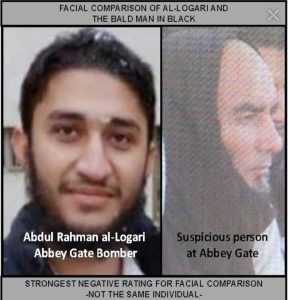What to Know:
The Department of Defense has identified the Islamic State– Khorasan Province (ISKP) militant responsible for the 2021 suicide bombing at Hamid Karzai International Airport’s Abbey Gate, which left 13 American service members and 170 civilians dead, in a recently released supplemental review of the attack’s initial investigation.
The review also confirmed that a person believed to be the bomber, which Marine Corps snipers requested to engage before the blast, was not the identified ISKP militant and that “positive identification of the bomber prior to the attack would have been improbable.”
The Bomber:

The review confirmed that the identity of the bomber responsible for the attack as Abdul Rahman al-Logari, who had been a member of ISKP since 2016. According to the review, Al-Logari “was one of thousands of ISIS-K members the Taliban released from a pair of detention centers in mid-August 2021” during their rapid takeover of the country.
According to ISKP’s Voice of Khorasan magazine, Logari had been an active terrorist within Islamic State networks for years before the attack, having been involved with an attempted suicide bombing plot against New Delhi, India, in 2017. He was captured by Indian intelligence services and turned over the CIA, who held him at the at Parwan prison near Bagram Air Base in Afghanistan. After he was released, he reportedly volunteered for the mission.
At approximately 5:50pm local time, al-Logari bypassed Taliban security and detonated his suicide vest in a crowded canal near Abby Gate.
A United States Army official stated that the review “determined ISIS-K would have still been able to conduct the attack regardless of whether al-Logari had been released, because the terror organization already had multiple suicide bombers available,” adding that “the attack at Abbey Gate was not preventable at the tactical level.”

ISKP had previously identified al-Logari as the attacker in a statement claiming responsibility in the hours following the bombing, but the review confirmed this through “analysis from across the intelligence community,” as well as facial recognition of photos of al-Logari taken while in Coalition custody.
The mastermind of the bombing is widely believed to be Rajab Salahudin, a key ISKP leader who commanded militant cells and planned operations in Kabul. According to Afghan security analyst and journalist Bilal Sarwary, Salahudin was previously trained by al-Qaeda in Waziristan before he joined the Haqqani Network (HQN) in 2009, where he work closely under Tajmir Jawad, a senior HQN leader and current Taliban General Directorate of Intelligence. When ISKP formed in 2015, Salahudin was placed in charge of operations in Kabul against Coalition forces and later the Taliban itself.
In April 2023, United States National Security Council spokesperson John Kirby confirmed that “the ISIS-K terrorist who was the mastermind of the horrific attack at Abbey Gate that killed 13 brave American service members and many others has been removed from the battlefield.” Other American officials confirmed to various media outlets that the killing was carried out by a Taliban raid earlier in the month in southern Afghanistan. One official told Politico that American forces did not cooperate with the Taliban in their operation, adding that American intelligence had independently confirmed the death with “a high level of confidence.”
The Man in Black:

A point of contention involving the bombing was reports that Marine Corps snipers had a visual on and requested to engage what they believed to be a potential bomber, dubbed “the man in black.”
The review stated that the Marine Corps “battalion commander exercised sound military judgement to conclude that the ‘bald man in black’ was not a lawful military target … Any portrayal of these events showing the battalion commander did not understand these events [is] just not supported by the evidence.”
Facial recognition technology confirmed that the “man in black” was not al-Logari, yielding the “strongest negative possible rating.”
An Army review team member was quoted as saying “Positive identification of the bomber prior to the attack would have been improbable, given the timeline and the density of the crowd” and that “intelligence available at the time lacked data that could have been used to identify al-Logari as the assailant.”
Likewise, a review team member told reporters during a briefing that “Over the past two years, some service members have claimed that they had the bomber in their sights and they could have prevented the attack. We now know that is not correct.”


